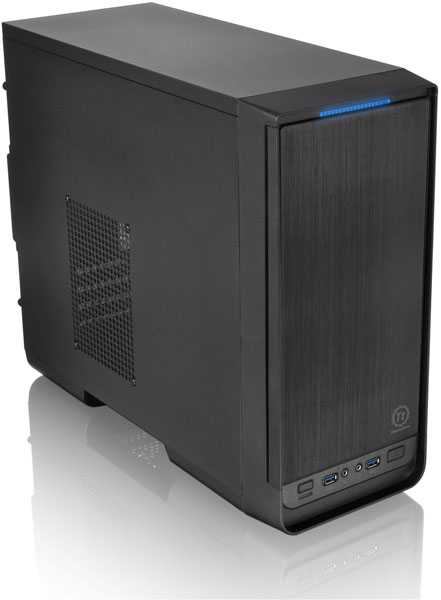- Qualcomm Launches Snapdragon 4 Gen 2 Mobile Platform
- AMD Launches Ryzen PRO 7000 Series Mobile & Desktop Platform
- Intel Launches Sleek Single-Slot Arc Pro A60 Workstation Graphics Card
- NVIDIA Announces Latest Ada Lovelace Additions: GeForce RTX 4060 Ti & RTX 4060
- Maxon Redshift With AMD Radeon GPU Rendering Support Now Available
Thermaltake Micro Chassis Twins Urban S1 and Urban SD1 Released
Thermaltake has released two PC chassis optimized for mATX and mITX systems. The S1 and the SD1 are both from the Urban line of chassis. The S1 is a mini-tower style of case, while the SD1 is more cube-like in appearance.
The Urban S1 features a brushed metal front door panel, establishing what Thermaltake calls a “simple, yet elegant aesthetic.” Further reinforcing this styling ethic are the classy blue LED occupying the top front edge of the Urban S1 and the I/O cluster on the bottom.

Speaking of the I/O cluster, it features a pair of high-speed USB 3.0 ports. These, along with the usual mic-in and headphone-out jacks, offer the end-user with easily accessible input/output connections for a chassis meant to be placed on top of the work desk.
As far as case cooling goes, the Urban S1 comes an 80mm fan pre-installed in the rear exhaust position. There is a mount for a 120mm fan at the front intake position, but it’s up to the end-user to install one. Augmenting the chassis’ cooling is a perforation on the left side panel through which air can pass through.
The Urban S1 can host up to two 5.25″ optical drives and a 3.5″ floppy drive externally, and up to five 3.5″ HDDs and a single 2.5″ SSD/HDD internally. It also has four PCI expansion slots and support for a standard PS2 PSU (sold separately).
A case as petite as the Urban S1 does have some limitations as far as the hardware it can host. CPU coolers taller than 148mm won’t fit; neither would GPUs longer than 260mm. Accordingly, system builders must plan their projects with these limitations in mind.
The Urban SD1 is a different case altogether. Squat and more ground-hugging in appearance, it exudes a more aggressive vibe compared to the S1. They do share some characteristics, particularly the brushed metal front door panel, the blue LED on the top edge, and the I/O port cluster on the bottom edge.

Where the two cases deviate from each other is the SD1’s feature set. For instance, it boasts modular storage device bays; you can choose to use the internal 3.5″ HDD bay, or you could take them out of the case completely if you wish. This would free up some space. The two 5.25″ optical drives are also mounted on their own drive bay. In fact, this particular drive bay is also where you install 5.25″ storage devices.
In addition to the modular storage devices, the Urban SD1 also features an option I’ve only seen on a few older high-end chassis: a retractable motherboard tray! It’s actually a bit of a thrill to see this type of feature on such a small-scale chassis, to be honest.
In terms of cooling, the Urban SD1 comes with a single 90mm fan installed up front, as well as a pair of 60mm fans mounted in the rear exhaust position. Moreover, it also is designed to host a radiator up to 140mm, so end users who have an AIO water-cooling system can use it in the Urban SD1.

Like its sister the S1, the Urban SD1 has four PCI expansion slots, as well as the same type and number of front panel I/O options. The specs for PSU compatibility are also the same. The size limitations for both an air cooler and GPU are different, however: CPU cooler height is restricted to 90mm, while GPUs up to 350mm long can fit in the Urban SD1.
At the time of writing, Thermaltake has not provided a precise date for when both its new Urban chassis will be available, nor has it disclosed any pricing information.



